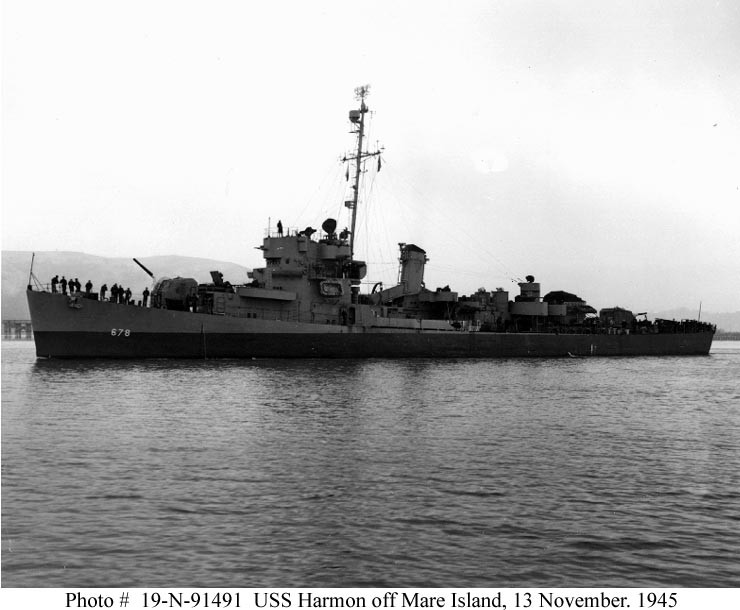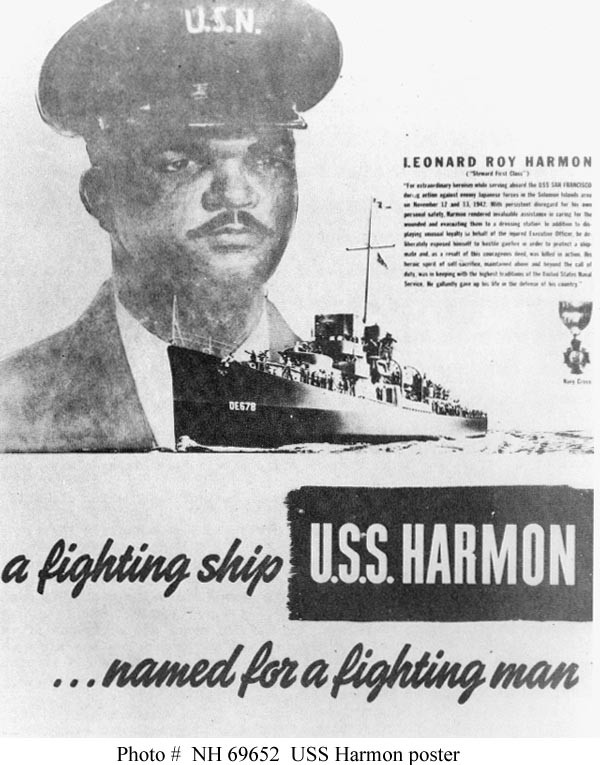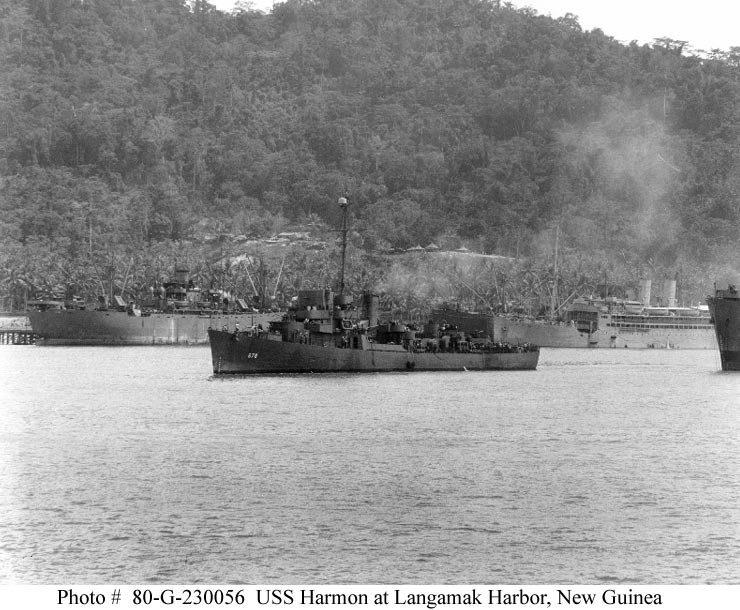Harmon (DE-678)
1943–1965

(DE-678: displacement 1,400; length 306'; beam 37'; draft 9'5" (mean); speed 23.5 knots; complement 186; armament 3 3-inch, 4 1.1-inch, 8 20 millimeter, 3 21-inch torpedo tubes, 8 depth charge projectors, 1 depth charge projector (Hedgehog), 2 depth charge tracks; class Buckley)

Additional Resources
U.S. Navy Ships Named in Honor of African Americans
Photo Section - USS Harmon (DE-678), 1943-1967
Harmon
Leonard Roy Harmon, born in Cuero, Tex., on 21 January 1917, enlisted in the U.S. Navy at Houston, Tex., on 10 June 1939 as a mess attendant third class (MAtt3c). After receiving training at the Naval Training Station, Naval Operating Base, Norfolk, Va., he traveled in heavy cruiser Tuscaloosa (CA-37) to join her sister ship San Francisco (CA-38). Harmon reported on board San Francisco on 28 October 1939. Advancements in rate followed: to MAtt2c on 16 August 1940, and to MAtt1c on 5 November 1941, a little over a month before Pearl Harbor.
On 12 November 1942, San Francisco was covering a force of transports disembarking reinforcements off Guadalcanal when Japanese land attack planes, carrying torpedoes, attacked. During the ensuing engagement, one of the enemy aircraft crashed San Francisco despite a withering barrage of antiaircraft fire, and caused "considerable damage and intense fires," demolishing the after control station and burning out Battle II, putting the after antiaircraft director and radar out of commission. One officer and 15 men were either killed outright or died of their injuries soon thereafter. Four officers, including Comdr. Mark H. Crouter, the executive officer, and 25 men were wounded, most suffering horrible burns. San Francisco transferred the wounded men to the transport President Jackson (AP-37), with one exception.
"Rather than submit to transfer for medical treatment," Comdr. Crouter, although in "intense pain and waning strength" from severe burns on both legs, insisted on remaining on board "so that he could be returned to duty in a minimum of time," exhibiting "sturdy endurance and courageous disregard for his own personal safety." MAtt1c Harmon had exhibited "unusual loyalty on behalf of" Crouter. It seems most likely that Harmon attended to the wounded executive officer before the young mess attendant had to proceed to his battle station later, for that night (12-13 November 1942), San Francisco fought again, this time in a desperate surface engagement at close quarters in the confined waters off Guadalcanal.
San Francisco suffered heavy damage from Japanese guns that ranged from 14-inch to machine guns. During the battle, a projectile plowed into Comdr. Crouter's cabin and exploded, inflicting fatal wounds. MAtt1c Harmon, meanwhile, was rendering "invaluable service in caring for the wounded and evacuating them to a dressing station" until, as he was working as a stretcher bearer topside, near the cruiser's secondary battery 5-inch mounts amidships, a 6-inch projectile from the secondary battery of the Japanese battleship Hiei struck in the vicinity and exploded. Shouting "Look out, Doc," Harmon moved to shield PhM3c Lynford L. Bondsteel from the lethal fragments, pushing him to the deck. Although Bondsteel managed to get his courageous shipmate below, Harmon died of his wounds soon thereafter.
___________________
The name Harmon was originally assigned to a Buckley-class destroyer escort (DE-72) that was transferred to the Royal Navy under lend-lease and renamed Aylmer (q.v.).
I
(DE-678: displacement 1,400; length 306'; beam 37'; draft 9'5" (mean); speed 23.5 knots; complement 186; armament 3 3-inch, 4 1.1-inch, 8 20 millimeter, 3 21-inch torpedo tubes, 8 depth charge projectors, 1 depth charge projector (Hedgehog), 2 depth charge tracks; class Buckley)
Harmon (DE-678), the first U.S. Navy ship to be named for an African American, was laid down on 5 May 1943 at Quincy, Mass. by Bethlehem Steel Co.; launched on 25 July 1943, sponsored by Mrs. Naunita Harmon Carroll, mother of the late Mess Attendant 1st Class Harmon; and commissioned at her builders' yard on 31 August 1943, Lt. Comdr. Kendall E. Read in command.
Harmon conducted her shakedown training out of Bermuda and then underwent post-shakedown repairs and alterations at Boston before dropping down the eastern seaboard to Norfolk, whence she sailed on 7 November 1943. Harmon transited the Panama Canal on 13 November to proceed to the South Pacific Area via San Francisco, Pearl Harbor, and Samoa. Arriving at on Christmas Day 1943, she reported for duty with Commander, South Pacific Force. For the next eight and a half months, she operated on escort duty throughout the South Pacific theater. On 18 September 1944, she sailed for Pearl Harbor, proceeding via Manus, in the Admiralty Islands, and Majuro, in the Marshalls.

Harmon underwent a navy yard availability at Pearl Harbor, trained in Hawaiian waters, and then made for the Admiralty Islands, where, on 24 November 1944, she joined the Seventh Fleet as part of Adm.l Richard L. Conolly's Luzon Reinforcement Group. Harmon sortied from Manus on 2 January 1945 with this large convoy and sailed ultimately arrived in the transport area to the east of Lingayen Gulf on 11 January.
On 5 March 1945, Harmon arrived off Iwo Jima to act as escort and antisubmarine screen. This duty lasted until 27 March 1945, when she proceeded to Pearl Harbor and reported to the 1st Fleet for training. She remained there until August when Harmon was ordered to Mare Island to increase her firepower by replacing her 3-inch guns with 5-inch mounts.
The war over, Harmon departed San Diego on 7 January 1946, bound for the Canal Zone, where she conducted training operations with submarines. Clearing Cristobal on 28 March, Harmon reached New London on 3 April 1946. There she again exercised with submarines until December 1946, before she proceeded to Green Cove Springs, Fla., where she was decommissioned on 25 March 1947 and joined the Atlantic Reserve Fleet.
Stricken from the Naval Vessel Register on 1 August 1965, the first U.S. Navy ship to be named for an African-American naval hero was sold to the North American Smelting Co., of Wilmington, Del., on 30 January 1967 to be broken up for scrap.
Harmon received three battle stars for World War II .
Robert J. Cressman
11 December 2012


